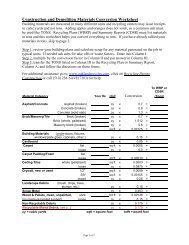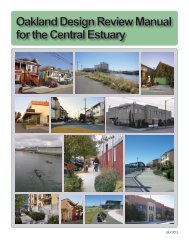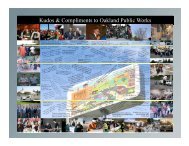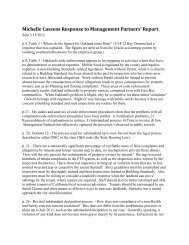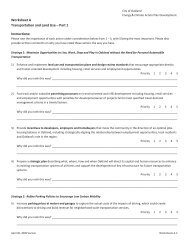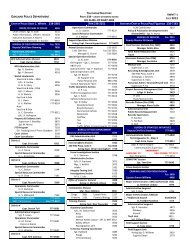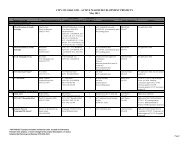Intelligent Transportation Systems - City of Oakland
Intelligent Transportation Systems - City of Oakland
Intelligent Transportation Systems - City of Oakland
You also want an ePaper? Increase the reach of your titles
YUMPU automatically turns print PDFs into web optimized ePapers that Google loves.
These detectors can be installed in both an overhead (forward looking) and in a side-fire<br />
mode. However, each comes with a trade<strong>of</strong>f. In a sidefire configuration, multiple lanes<br />
(up to eight) can be detected, but the detector must be mounted at least 10 feet away<br />
from the nearest detection zone. In an overhead “forward-looking” configuration the<br />
highest accuracy is achieved, but each sensor can only detect one lane. Signal bending<br />
around objects (e.g., trucks) has been claimed but not proven.<br />
Vehicle Detection Recommendations - For the <strong>City</strong> <strong>of</strong> <strong>Oakland</strong>, it is recommended<br />
that VID systems be implemented to gradually replace loop detectors at signalized<br />
intersections. This will ease the maintenance burden associated with loop detectors.<br />
In addition, it is recommended that the <strong>City</strong> <strong>of</strong> <strong>Oakland</strong> implement vehicle detectors at<br />
mid-block locations on key corridors to collect real time speed, volume and occupancy<br />
data. VID systems could be used for this purpose as they have proven to be very<br />
effective performing this function. However, for detecting vehicles at mid block locations,<br />
microwave sensors are another good alternative that should be considered. These<br />
sensors are also referred to as microwave vehicle detection systems (MVDS).<br />
MVDS are recommended for mid block vehicle detection since they have proven to be<br />
reliable and accurate and since they are being implemented on San Pablo Avenue, San<br />
Leandro Boulevard and International Boulevard as part <strong>of</strong> the SMART Corridors<br />
Program. Since the <strong>City</strong> <strong>of</strong> <strong>Oakland</strong> is already operating the s<strong>of</strong>tware that is required to<br />
access MVDS data through SMART Corridors ATMS, additional MVDS locations could<br />
be integrated into the existing SMART Corridors ATMS at a minimal cost. There is no<br />
need for the <strong>City</strong> to purchase additional computer hardware or s<strong>of</strong>tware to access mid<br />
block vehicle detectors. In addition, it may be more efficient for <strong>City</strong> <strong>of</strong> <strong>Oakland</strong> staff to<br />
have just one s<strong>of</strong>tware program to access mid block speed, volume and occupancy<br />
data. Finally, if additional MVDS locations are integrated into the SMART Corridor<br />
ATMS, the <strong>City</strong> <strong>of</strong> <strong>Oakland</strong> will be benefiting traffic management on a regional level as<br />
well since other SMART Corridor partner agencies will have access to these new MVDS<br />
locations.<br />
The Port <strong>of</strong> <strong>Oakland</strong> has expressed as desire to access real time speed, volume, and<br />
occupancy data from the <strong>City</strong> <strong>of</strong> <strong>Oakland</strong>’s MVDS, specifically for sensors on<br />
Hegenberger Road, 98 th Avenue, and Doolittle Drive. This could be accomplished by<br />
either providing the Port <strong>of</strong> <strong>Oakland</strong> with a SMART Corridor workstation or by<br />
establishing a C2C connection between the <strong>City</strong> <strong>of</strong> <strong>Oakland</strong> TMC and the Port <strong>of</strong><br />
<strong>Oakland</strong>.<br />
4.2.3 Dynamic Message Signs (DMS)<br />
DMS can be used to convey real time messages to motorists on freeways or on city<br />
streets. DMS installed on freeways tend to be much larger than those installed on city<br />
streets. All DMS are usually controlled by an operator located in a TMC.<br />
DMS installed on city streets can be used to provide advanced information to drivers on<br />
current traffic conditions or to communicate other community information such as special<br />
events at the Coliseum. DMS can provide dynamic information to motorists regarding a<br />
variety <strong>of</strong> conditions, including:<br />
<strong>City</strong> <strong>of</strong> <strong>Oakland</strong> ITS Strategic Plan<br />
39 September, 2003







